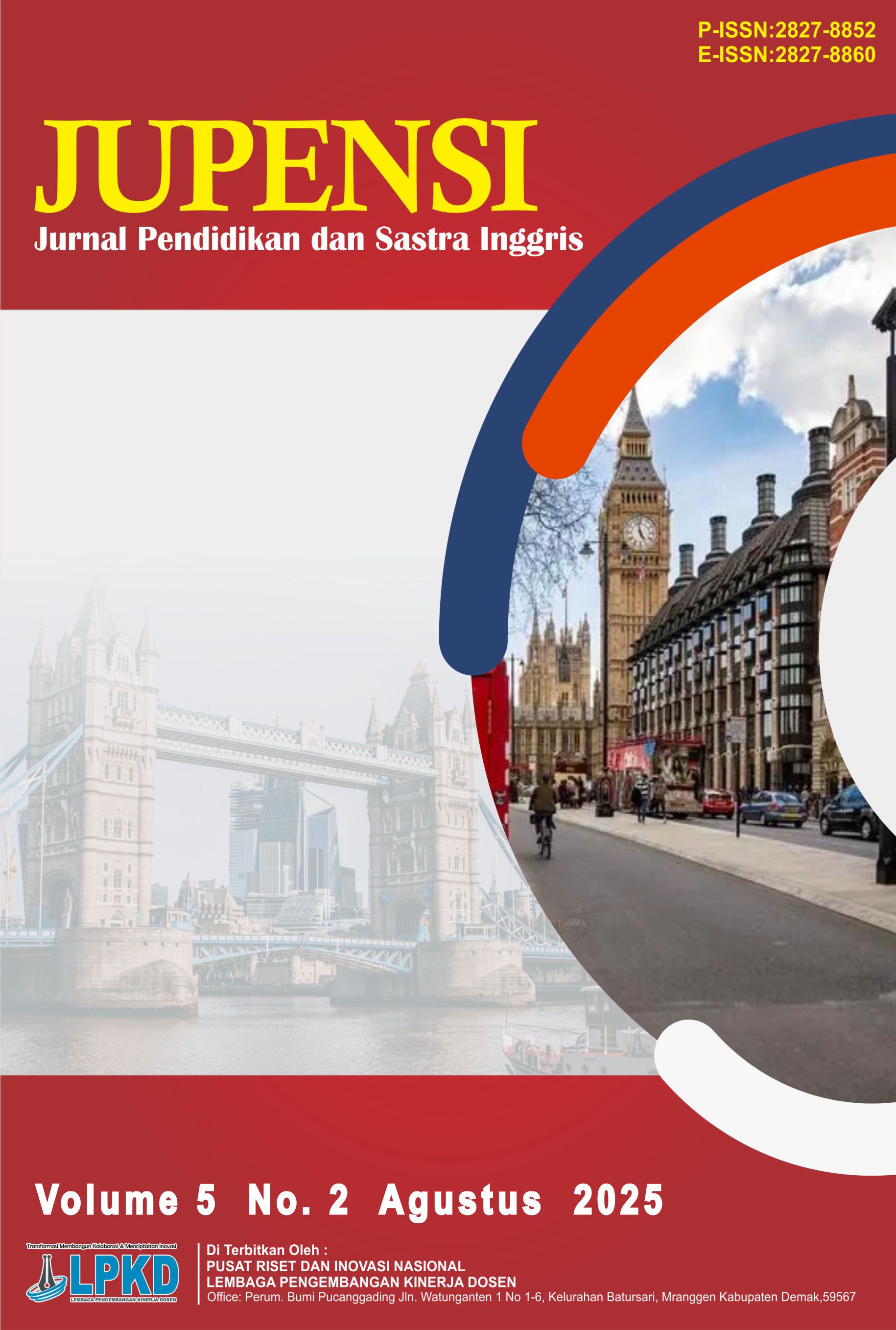English Teacher’s Strategies in Enhancing 9th Grade Students’ Critical Thinking at Junior High School 25 Muaro Jambi
DOI:
https://doi.org/10.55606/jupensi.v5i2.5617Keywords:
Classroom strategies, Critical thinking, English learning, Instructional methods, Teacher’s strategiesAbstract
The aim of this research was to describe the English teacher’s strategies in enhancing the critical thinking skills of 9th grade students at Junior High School 25 Muaro Jambi. This study employed a qualitative descriptive method, with data collected through observation and interviews. The data were analyzed using the interactive model proposed by Miles and Huberman (1994), which includes data reduction, data display, and conclusion drawing/verification. The findings revealed that the teacher’s instructional strategies played a crucial role in fostering the development of students’ critical thinking skills. The teacher implemented various approaches such as posing open-ended questions, facilitating classroom discussions, conducting debates, and assigning writing tasks. These strategies were designed to promote analytical thinking and encourage students to express and defend their opinions. In addition to these core strategies, the teacher also used a combination of teaching methods, including reading comprehension exercises, translation and interpretation of texts, dictionary use, group work, dialogue practice, storytelling, vocabulary games, and writing simple essays for daily communication. These methods not only engaged students in active learning but also made the learning process more dynamic and enjoyable. As a result, students were able to think more clearly, quickly, and effectively, which significantly contributed to the development of their critical thinking abilities. The research concludes that a diverse and interactive set of teaching strategies can successfully enhance critical thinking among junior high school students. Teachers are encouraged to integrate a variety of methods tailored to students’ needs and classroom contexts to achieve optimal learning outcomes and better prepare students for higher-level thinking and problem-solving.
Downloads
References
Asfiranti, F., Fatoni, M., Verina, N., & Putri, W. (2025). Pre-service English teachers’ experience in implementing critical thinking in English teaching and learning. 6(June), 1–14.
Casmini, N. L., Redhana, I. W., & Suma, I. K. (2024). Exploring the impact of teaching strategies on students’ critical thinking skills in chemistry. Mimbar Ilmu, 29(3), 422–431. https://doi.org/10.23887/mi.v29i3.90701
Darminto, D., Handoyo, E., Wardani, S., Subali, B., & Widiarti, N. (2025). Effective teaching strategies to enhance critical thinking skills in education: A literature review. Edunesia: Jurnal Ilmiah Pendidikan, 6(2), 948–964. https://doi.org/10.51276/edu.v6i2.1227
Hakim, L. N., Rachmawati, E., & Purwaningsih, S. (2020). Teachers’ strategies in developing students’ critical thinking and critical reading. Pedagogia: Jurnal Pendidikan, 10(1), 11–19. https://doi.org/10.21070/pedagogia.v10i1.1036
Hapsari, M. S., Qalyubi, I., & Widiastuty, H. (2025). Exploring teacher’s strategies and challenges in enhancing student’s critical thinking skills in reading at MTsN 1 Kota Palangka Raya. 8(4), 993–1004.
Iskandar, N., Mustaji, M., Jannah, M., & Wicaksono, S. R. (2021). The problem-based learning in enhancing students’ critical thinking for reading skills in English teaching at vocational school. IJORER: International Journal of Recent Educational Research, 2(2), 237–249. https://doi.org/10.46245/ijorer.v2i2.93
Muliyanti, T. (2021). Teacher’s strategy in promoting critical thinking skill in online learning and teaching of 11th grade Bahasa at MAN 1 Jember in the academic year 2020/2021. 1.
Muthoharoh, R. J., & Hartono, H. (2022). Enhancing students’ critical thinking skills in reading class using the directed reading thinking activity (DRTA) teaching strategy. EduLite: Journal of English Education, Literature and Culture, 7(2), 224–232. https://doi.org/10.30659/e.7.2.224-232
Novita, I. G. A. P., & Paragae, S. (2023). Innovative teaching strategies in teaching English as a foreign language. English Teaching and Linguistics Journal (ETLiJ), 4(1), 1–9. https://doi.org/10.30596/etlij.v4i1.12990
Nyoman, N., Sariasih, F., Made, I. A., Widiastuti, S., Made, N., & Murtini, W. (2023). Improving reading comprehension of the ninth-grade students of SMP N 2 Kuta in academic year 2022/2023 through brainstorming. Academic Journal on English Studies, 3(1).
Rahima, A. R., Kadariyah, N., & Hasanah, N. I. (2023). The use of questioning strategy in promoting students critical thinking. Journal of English Language Teaching and English Linguistics, 8(2), 69–79. https://doi.org/10.31316/eltics.v8i2.5212
Rohmi, F., & Wahyuni, S. (2024). English teacher’s strategy in teaching writing using discovery learning. Jurnal Pendidikan Bahasa Inggris Undiksha, 11(2), 122–128. https://doi.org/10.23887/jpbi.v11i2.50812
Sari, B. N., Ardini, S. N., & Budiman, T. C. (2024). The implementation of STEAM in teaching English to enhance critical thinking using the Pancasila student profile concept. Journal of English Language Learning, 8(2), 719–729. https://doi.org/10.31949/jell.v8i2.12027
Yazidi, R. E. (2023). Strategies for promoting critical thinking in the classroom. International Journal of English Literature and Social Sciences, 8(2), 026–040. https://doi.org/10.22161/ijels.82.5
Downloads
Published
How to Cite
Issue
Section
License
Copyright (c) 2025 Jurnal Pendidikan dan Sastra Inggris

This work is licensed under a Creative Commons Attribution-ShareAlike 4.0 International License.









